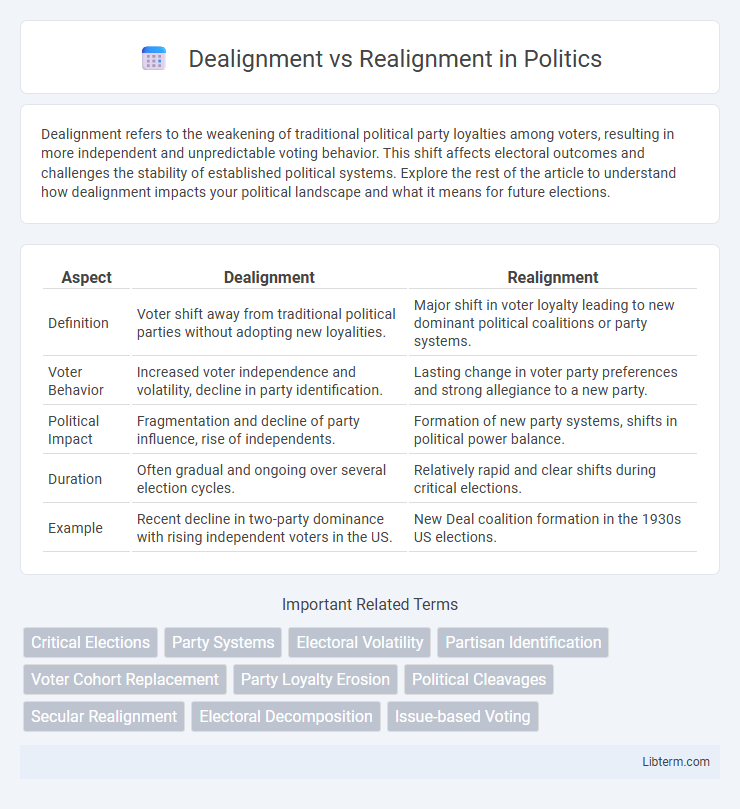Dealignment refers to the weakening of traditional political party loyalties among voters, resulting in more independent and unpredictable voting behavior. This shift affects electoral outcomes and challenges the stability of established political systems. Explore the rest of the article to understand how dealignment impacts your political landscape and what it means for future elections.
Table of Comparison
| Aspect | Dealignment | Realignment |
|---|---|---|
| Definition | Voter shift away from traditional political parties without adopting new loyalities. | Major shift in voter loyalty leading to new dominant political coalitions or party systems. |
| Voter Behavior | Increased voter independence and volatility, decline in party identification. | Lasting change in voter party preferences and strong allegiance to a new party. |
| Political Impact | Fragmentation and decline of party influence, rise of independents. | Formation of new party systems, shifts in political power balance. |
| Duration | Often gradual and ongoing over several election cycles. | Relatively rapid and clear shifts during critical elections. |
| Example | Recent decline in two-party dominance with rising independent voters in the US. | New Deal coalition formation in the 1930s US elections. |
Introduction to Political Alignment
Political alignment shapes electoral dynamics through patterns of party loyalty and voter behavior. Dealignment occurs when traditional party affiliations weaken, leading to increased voter volatility and independent identification. Realignment involves a significant, lasting shift in the political landscape, often triggered by critical elections or social changes that redefine party coalitions and voter bases.
Defining Dealignment
Dealignment refers to the decline in voter loyalty to traditional political parties, resulting in increased support for independent or third-party candidates. This phenomenon showcases a weakening of long-standing party identification, leading to more volatile and unpredictable election outcomes. Key factors contributing to dealignment include voter dissatisfaction, demographic changes, and shifting social attitudes.
Defining Realignment
Realignment refers to a significant and lasting shift in the political landscape where voter preferences, party coalitions, and issue priorities undergo transformative changes, often triggered by critical elections. This process reshapes the balance of power between major political parties, leading to the emergence of new dominant party systems or the reconfiguration of existing ones. Realignment contrasts with dealignment, which involves voter disengagement and weakening party loyalty without substantive shifts in party dominance.
Historical Context of Dealignment
The historical context of dealignment is rooted in the decline of traditional party loyalties and voter identification with major political parties, particularly observable in the United States and Western democracies since the 1960s. This trend emerged from factors such as increased political polarization, demographic changes, and a growing distrust in political institutions, leading to higher voter volatility and a rise in independent or third-party candidates. Dealignment contrasts with realignment, where shifting party coalitions and voter bases permanently alter the political landscape, as dealignment reflects a more fragmented and fluid partisan commitment without a stable new equilibrium.
Notable Examples of Realignment
The 1932 U.S. presidential election is a notable example of realignment, marking the Democratic Party's dominance through Franklin D. Roosevelt's New Deal coalition. The 1968 election reflected a significant realignment with the Southern Strategy shifting many Southern states from Democratic to Republican loyalty. Another key instance is the 1980 election, where Ronald Reagan's victory solidified conservative realignment, reshaping the political landscape for decades.
Causes of Political Dealignment
Political dealignment occurs when voters gradually disengage from traditional party loyalties due to factors such as increased political cynicism, distrust in government institutions, and dissatisfaction with party platforms. Social changes, including rising individualism, demographic shifts, and the influence of new media, contribute to the weakening of established party identification. Economic instability and perceived party failure to address critical issues further accelerate voter alienation, leading to decreased electoral participation and unpredictable voting patterns.
Factors Driving Realignment
Factors driving realignment include significant demographic shifts, changes in party platforms, and critical election issues that reshape voter coalitions. Economic transformations and social movements influence voter allegiance, leading to new political coalitions forming around emerging interests. Campaign strategies leveraging media and technology also play a crucial role in accelerating realignment by targeting shifting voter priorities.
Impact on Voter Behavior
Dealignment leads to a decline in party loyalty as voters increasingly identify as independents or switch allegiances, causing unpredictable election outcomes. Realignment results in a lasting shift in voter coalitions and party dominance, often triggered by critical elections that redefine political priorities. Both phenomena significantly reshape voter behavior, influencing turnout rates and the stability of political systems.
Consequences for Political Parties
Dealignment weakens traditional party loyalties, leading to more volatile voter bases and increased difficulty in predicting election outcomes. Realignment creates durable shifts in party support, often resulting in the emergence of dominant party coalitions and long-term changes in policy agendas. Both phenomena significantly impact party strategies, candidate selection, and coalition-building efforts.
Future Trends in Political Alignment
Future trends in political alignment indicate increasing dealignment as voter loyalty to traditional parties weakens, driven by growing polarization, social media influence, and issue-based voting. Realignment may occur in response to major societal shifts, such as demographic changes or economic upheavals, prompting the emergence of new coalitions and political movements. Analysts predict that hybrid patterns of dealignment and realignment will redefine party systems, emphasizing adaptive strategies and diverse voter bases in the coming decades.
Dealignment Infographic

 libterm.com
libterm.com